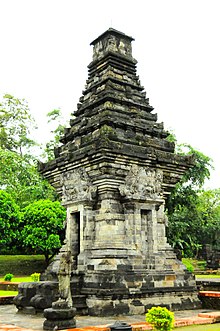Penataran
Coordinates: 8°0′58″S 112°12′33″E / 8.01611°S 112.20917°E

Penataran or Panataran (Indonesian: Candi Penataran) is one of the largest Hindu temple ruins complex in East Java, Indonesia.[1] It is located roughly 12 km northeast of Blitar, with the closest airport being farther away at Malang. Believed to have been constructed between the 12th century to the 15th century, the temple played a significant role in the Majapahit Kingdom, especially under King Hayam Wuruk.[1][2] He considered his favorite sanctuary.[3]: 241 Penataran dates from the Kediri era.
Candi Panataran is a Shiva (Siwa) temple. It is notable for including one of the largest Indonesian collection of reliefs showing life stories of Hindu god Vishnu in different avatar. In particular, the temple site include the Rama story in the Javanese version of the epic Ramayana, as well Krishna story as depicted Triguna's Krishnayana epic poem.[4][5][3]: 158 Comparative studies of reliefs related to Hindu epics at Penataran and Prambanan temple (Yogyakarta) complexes have attracted the attention of archaeologists.[6]
World Heritage status[]

This site was added to the UNESCO World Heritage Tentative List on October 19, 1995 in the Cultural category. This temple was identified in Nagarakretagama as Palah temple and reported being visited by King Hayam Wuruk during his royal tour across East Java. The site is being considered to be put on the World Heritage list of sites that have "outstanding universal value" to the world.[7] However, on 2015, the site was pulled out from the tentative list along with 11 other sites.
See also[]
- Angkor Wat
- Bali
- Hinduism in Indonesia
References[]
- ^ Jump up to: a b Lydia Kieven (2013). Following the Cap-Figure in Majapahit Temple Reliefs: A New Look at the Religious Function of East Javanese Temples, Fourteenth and Fifteenth Centuries. BRILL. pp. 161–175. ISBN 978-90-04-25865-5.
- ^ "Penataran Temple - One of Majapahit Inheritance in Blitar". East Java.com. Retrieved 6 May 2012.
- ^ Jump up to: a b Cœdès, George (1968). The Indianized states of Southeast Asia. University of Hawaii Press. ISBN 9780824803681.
- ^ Jan Fontein (1973), The Abduction of Sitā: Notes on a Stone Relief from Eastern Java, Boston Museum Bulletin, Vol. 71, No. 363 (1973), pp. 21-35
- ^ James R. Brandon (2009). Theatre in Southeast Asia. Harvard University Press. pp. 15–27. ISBN 978-0-674-02874-6.
- ^ Willem Frederik Stutterheim (1989). Rāma-legends and Rāma-reliefs in Indonesia. Abhinav Publications. pp. 109–111, 161–172. ISBN 978-81-7017-251-2.
- ^ "Penataran Hindu Temple Complex". UNESCO. Retrieved 6 May 2012.
- Majapahit
- World Heritage Sites in Indonesia
- Blitar
- Buildings and structures in East Java
- Hindu temples in Indonesia
- 12th-century Hindu temples
- Cultural Properties of Indonesia in East Java
- Tourist attractions in East Java
- Asian religious building and structure stubs
- Indonesian building and structure stubs


